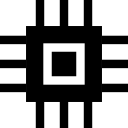Computer organization: Difference between revisions
(Created page with "right|frame|Computer Organization<ref>http://www.flaticon.com/</ref> This is pretty straight forward stuff. Nothing especially technical. We are concerned wi...") |
No edit summary |
||
| Line 1: | Line 1: | ||
[[file:cpu.png|right|frame|Computer Organization<ref>http://www.flaticon.com/</ref>]] | [[file:cpu.png|right|frame|Computer Organization<ref>http://www.flaticon.com/</ref>]] | ||
How does a computer '''actually work'''? How do they transform what you type into a program that shows cute cat pictures? | |||
== The big ideas in | == The big ideas in computer organization == | ||
*[[2.1.1 Outline the architecture of the central processing unit (CPU) and the functions of the arithmetic logic unit (ALU) and the control unit (CU) and the registers within the CPU. Level: 2]] | |||
*[[2.1.2 Describe primary memory. Level: 2]] | |||
*[[2.1.3 Explain the use of cache memory. Level: 3]] | |||
*[[2.1.4 Explain the machine instruction cycle. Level: 3]] | |||
*[[2.1.5 Identify the need for persistent storage. Level: 2]] | |||
*[[2.1.6 Describe the main functions of an operating system. Level: 2]] | |||
*[[2.1.7 Outline the use of a range of application software. Level: 2]] | |||
*[[2.1.8 Identify common features of applications. Level: 2]] | |||
*[[2.1.9 Define the terms: bit, byte, binary, denary/decimal, hexadecimal. Level: 1]] | |||
*[[2.1.10 Outline the way in which data is represented in the computer. Level: 2]] | |||
*[[2.1.11 Define the Boolean operators: AND, OR, NOT, NAND, NOR and XOR. Level: 1]] | |||
*[[2.1.12 Construct truth tables using the above operators. Level: 3]] | |||
*[[2.1.13 Construct a logic diagram using AND, OR, NOT, NAND, NOR and XOR gates. Level: 3]] | |||
== References == | == References == | ||
<references /> | <references /> | ||
[[Category: | [[Category:Computer Organization]] | ||
Revision as of 07:34, 12 April 2016

Computer Organization[1]
How does a computer actually work? How do they transform what you type into a program that shows cute cat pictures?
The big ideas in computer organization
- 2.1.1 Outline the architecture of the central processing unit (CPU) and the functions of the arithmetic logic unit (ALU) and the control unit (CU) and the registers within the CPU. Level: 2
- 2.1.2 Describe primary memory. Level: 2
- 2.1.3 Explain the use of cache memory. Level: 3
- 2.1.4 Explain the machine instruction cycle. Level: 3
- 2.1.5 Identify the need for persistent storage. Level: 2
- 2.1.6 Describe the main functions of an operating system. Level: 2
- 2.1.7 Outline the use of a range of application software. Level: 2
- 2.1.8 Identify common features of applications. Level: 2
- 2.1.9 Define the terms: bit, byte, binary, denary/decimal, hexadecimal. Level: 1
- 2.1.10 Outline the way in which data is represented in the computer. Level: 2
- 2.1.11 Define the Boolean operators: AND, OR, NOT, NAND, NOR and XOR. Level: 1
- 2.1.12 Construct truth tables using the above operators. Level: 3
- 2.1.13 Construct a logic diagram using AND, OR, NOT, NAND, NOR and XOR gates. Level: 3